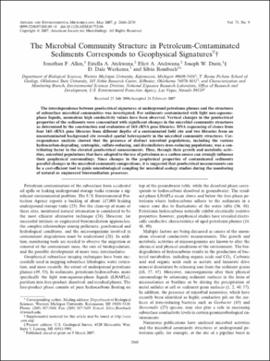| dc.contributor.author | Allen, Jonathan P. | |
| dc.contributor.author | Atekwana, Estella A. | |
| dc.contributor.author | Atekwana, Eliot A. | |
| dc.contributor.author | Duris, Joseph W. | |
| dc.contributor.author | Werkema, D. Dale | |
| dc.contributor.author | Rossbach, Silvia | |
| dc.date.accessioned | 2018-08-29T14:24:37Z | |
| dc.date.available | 2018-08-29T14:24:37Z | |
| dc.date.issued | 2007-05 | |
| dc.identifier | oksd_allen_themicrobialcom_2007 | |
| dc.identifier.citation | Allen, J. P., Atekwana, E. A., Atekwana, E. A., Duris, J. W., Werkema, D. D., & Rossbach, S. (2007). The microbial community structure in petroleum-contaminated sediments corresponds to geophysical signatures. Applied and Environmental Microbiology, 73(9), 2860-2870. https://doi.org/10.1128/AEM.01752-06 | |
| dc.identifier.uri | https://hdl.handle.net/11244/301619 | |
| dc.description.abstract | The interdependence between geoelectrical signatures at underground petroleum plumes and the structures of subsurface microbial communities was investigated. For sediments contaminated with light non-aqueous-phase liquids, anomalous high conductivity values have been observed. Vertical changes in the geoelectrical properties of the sediments were concomitant with significant changes in the microbial community structures as determined by the construction and evaluation of 16S rRNA gene libraries. DNA sequencing of clones from four 16S rRNA gene libraries from different depths of a contaminated field site and two libraries from an uncontaminated background site revealed spatial heterogeneity in the microbial community structures. Correspondence analysis showed that the presence of distinct microbial populations, including the various hydrocarbon-degrading, syntrophic, sulfate-reducing, and dissimilatory-iron-reducing populations, was a contributing factor to the elevated geoelectrical measurements. Thus, through their growth and metabolic activities, microbial populations that have adapted to the use of petroleum as a carbon source can strongly influence their geophysical surroundings. Since changes in the geophysical properties of contaminated sediments parallel changes in the microbial community compositions, it is suggested that geoelectrical measurements can be a cost-efficient tool to guide microbiological sampling for microbial ecology studies during the monitoring of natural or engineered bioremediation processes. | |
| dc.format | application/pdf | |
| dc.language | en_US | |
| dc.publisher | American Society for Microbiology | |
| dc.rights | This material has been previously published. In the Oklahoma State University Library's institutional repository this version is made available through the open access principles and the terms of agreement/consent between the author(s) and the publisher. The permission policy on the use, reproduction or distribution of the material falls under fair use for educational, scholarship, and research purposes. Contact Digital Resources and Discovery Services at lib-dls@okstate.edu or 405-744-9161 for further information. | |
| dc.title | Microbial community structure in petroleum-contaminated sediments corresponds to geophysical signatures | |
| osu.filename | oksd_allen_themicrobialcom_2007.pdf | |
| dc.description.peerreview | Peer reviewed | |
| dc.identifier.doi | 10.1128/AEM.01752-06 | |
| dc.description.department | Geology | |
| dc.type.genre | Article | |
| dc.type.material | Text | |
| dc.subject.keywords | bacteria | |
| dc.subject.keywords | ecosystem | |
| dc.subject.keywords | electric conductivity | |
| dc.subject.keywords | gene library | |
| dc.subject.keywords | geologic sediments | |
| dc.subject.keywords | phylogeny | |
| dc.subject.keywords | dna primers | |
